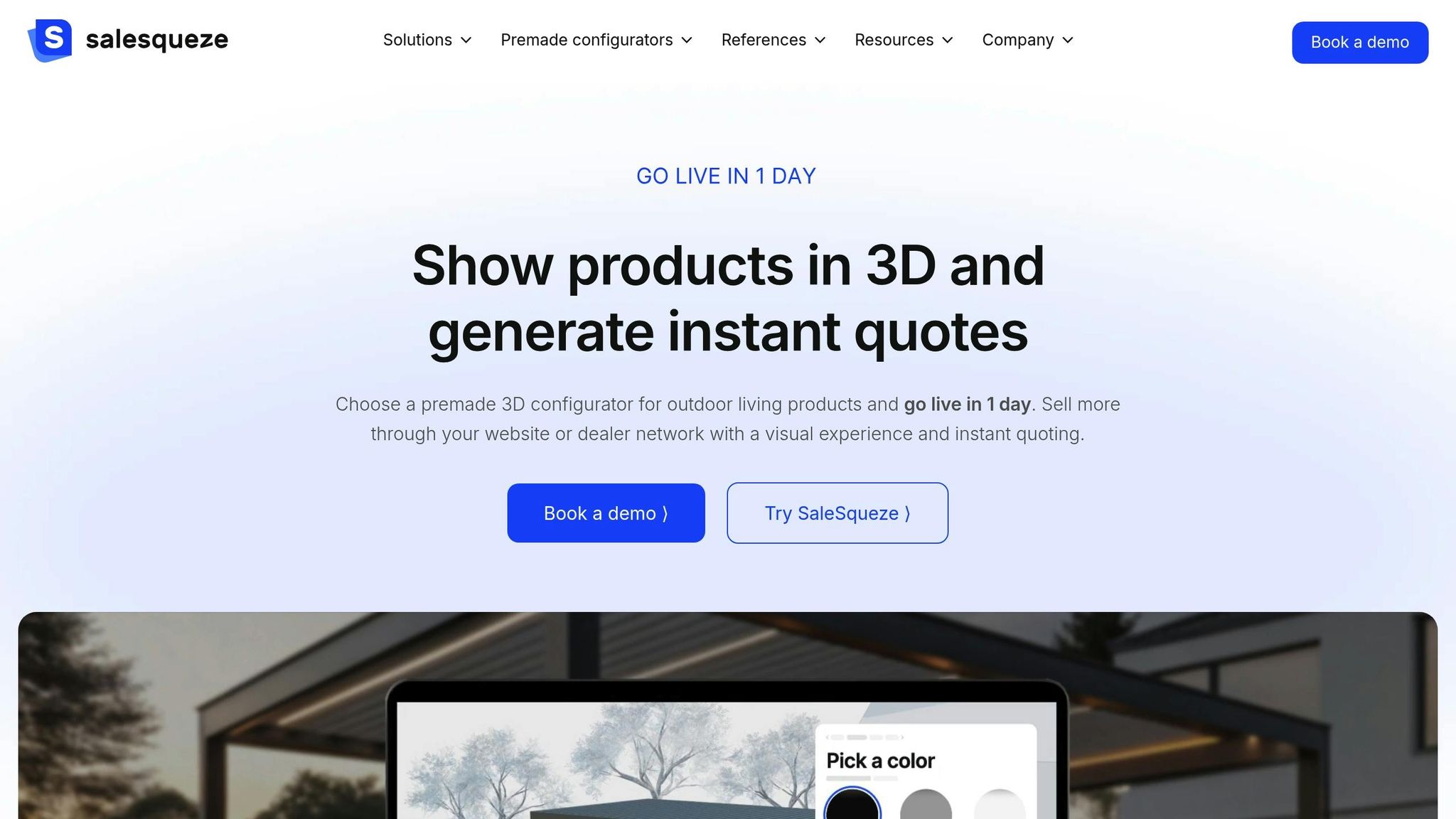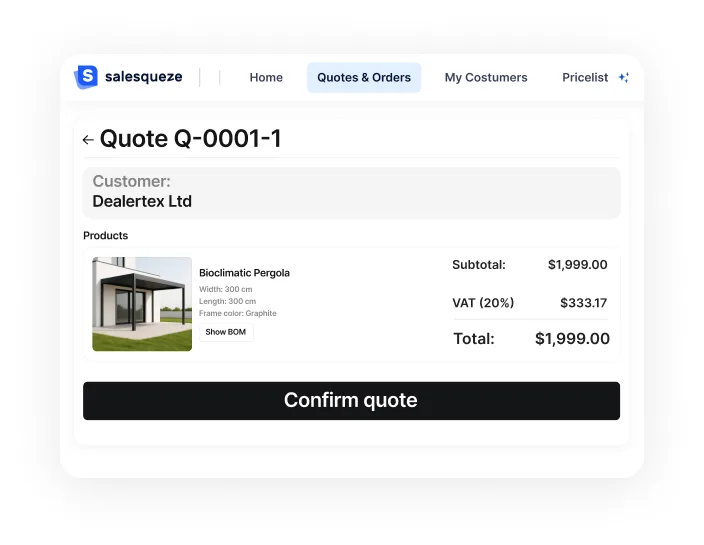Pricing configurators are transforming how outdoor living businesses handle quotes. Unlike manual quoting, which is slow and prone to errors, configurators generate instant, accurate, and professional quotes tailored to customer needs. They simplify complex pricing for customizable products like pergolas and outdoor kitchens, offering real-time visuals and pricing updates. This not only saves time but also improves customer experience.
Key Takeaways:
- Speed: Configurators produce quotes instantly, while manual methods can take days or weeks.
- Accuracy: Automation eliminates errors common in manual calculations.
- Customer Experience: Interactive tools with 3D visuals engage buyers better than static spreadsheets.
- Scalability: Configurators handle more quotes without needing extra staff.
Quick Comparison:
| Feature | Pricing Configurators | Manual Quotes |
|---|---|---|
| Quote Speed | Instant | Hours to Days |
| Error Rates | Minimal | High |
| Customization | Real-time and Visual | Limited or Static |
| Sales Efficiency | Increased | Staff-dependent |
| Scalability | High | Limited |
| Customer Experience | Engaging and Interactive | Static and Frustrating |
For outdoor living businesses, configurators offer a faster, more accurate, and customer-friendly approach to quoting, helping them stay competitive in a growing market.
What Are Pricing Configurators
Pricing configurators simplify and speed up the quoting process for customizable products. They allow users to adjust options in real time and instantly generate professional quotes. This tackles the common challenges of speed and accuracy in quoting. Think of them as smart tools that combine product visualization, dynamic pricing, and automated documentation into a single, efficient system.
How Pricing Configurators Work
Today’s pricing configurators integrate real-time visualization, dynamic pricing, and production workflows seamlessly. Users start by selecting a base product and customizing it through an interactive interface. The system enforces manufacturing rules, suggests alternatives, and updates visuals – like 2D, 3D, or 360° views – immediately. Plus, it generates production-ready outputs such as bills of materials (BOMs), CAD files, and detailed specifications.
How Configurators Speed Up Sales
By removing manual steps, pricing configurators deliver quick, pre-configured quotes. This speeds up the quote-to-sale process significantly, helping sales teams maintain momentum throughout the year.
Benefits for Outdoor Living Products
Outdoor living products often come with a wide range of customizable options – like sizes, materials, colors, add-ons, and site-specific adjustments – leading to a nearly endless number of combinations. For instance, Aluliving, a European manufacturer, adopted a CPQ configurator through SaleSqueze. This replaced static brochures with an interactive tool that enforces design rules, updates pricing instantly, and showcases live 3D models. The result? A faster and more efficient buying experience.
Configurators also help dealers focus on complex, high-margin products by simplifying the quoting process. For manufacturers, automation allows them to grow their market presence without needing to scale up support teams proportionally. This approach is a stark improvement over traditional manual quoting methods, as explored in the next section.
How Manual Quoting Works
Manual quoting remains a staple for many outdoor living businesses, even though it comes with its fair share of challenges. This traditional method relies heavily on human expertise, spreadsheets, and time-consuming calculations to generate quotes for customers. Understanding how this process works sheds light on why companies are increasingly searching for faster, more reliable alternatives.
The Manual Quote Process
Creating a manual quote for outdoor living projects typically involves a series of steps. First, sales teams gather detailed project information from customers. This includes property dimensions, desired features, material preferences, and installation specifics. Multiple back-and-forth communications are often needed to ensure all details are accurate.
Once the necessary information is collected, estimators use tools like Excel spreadsheets and rely on their internal knowledge to calculate costs. These calculations cover materials, labor, shipping, and profit margins, while also ensuring that all components are compatible with each other.
Finally, the quote is formatted into a professional document. This step often requires multiple rounds of revisions and approvals before it’s ready to be shared with the customer. Depending on the complexity of the project and team availability, the entire process can take anywhere from several days to weeks. This lengthy timeline often leads to inefficiencies and errors, which we’ll explore next.
Problems with Manual Quotes
Manual quoting presents several challenges that can disrupt operations and frustrate customers. The process is prone to errors, especially when dealing with complex outdoor configurations involving custom dimensions and multiple components. A single miscalculation could result in financial losses or project delays, making accuracy a critical concern.
Another issue is the reliance on key personnel. If those individuals are unavailable, the entire process can stall. Training new team members to understand intricate pricing structures and product details further slows things down, creating additional bottlenecks.
For example, Fortress Building Products experienced significant delays in their manual quoting process, with average wait times stretching to weeks between a customer’s request and the delivery of a quote. These delays hindered their ability to serve customers efficiently and highlighted the operational inefficiencies of manual workflows.
Customer Experience Issues
The drawbacks of manual quoting don’t just affect operations – they also impact the customer experience. Long wait times for quotes can frustrate potential buyers, pushing them to explore competitors who respond faster. Additionally, traditional quotes with static visuals fail to provide the engaging representations customers need to fully envision their projects.
Seasonal demand spikes further strain manual processes, leading to even longer delays. Without the ability to provide immediate pricing feedback during consultations, businesses risk miscommunication and missed sales opportunities. Inconsistent information from different team members can also shake customer confidence.
These challenges can have measurable consequences for businesses. For instance, the broader retail industry saw $743 billion worth of merchandise returns – 14.5% of total sales – with many of these returns stemming from mismatched expectations. A more precise and visually engaging quoting process could help mitigate such issues.
Pricing Configurators vs Manual Quotes
Let’s dive into how pricing configurators stack up against manual quotes in terms of speed, accuracy, and customer experience, and why these differences matter for outdoor living sales.
Speed Comparison
When it comes to speed, the gap between pricing configurators and manual quotes is enormous. Manual quotes can take anywhere from several days to weeks to finalize, while pricing configurators generate quotes instantly. In fact, pricing configurators can reduce the quote-to-cash cycle by 40%. This is a game-changer, especially during peak seasons when manual processes often create frustrating delays.
Speed isn’t just about saving time – it’s about keeping customers engaged. With pricing configurators, sales teams can provide instant feedback during consultations, avoiding the need for follow-up meetings just to deliver quotes. This immediacy helps keep potential customers from wandering off to competitors while waiting for a response.
Accuracy and Error Rates
Speed is great, but accuracy is just as important. Manual quoting processes are error-prone due to outdated price lists, miscalculated discounts, or incorrect product configurations. These mistakes can hurt profit margins and damage trust with customers.
Pricing configurators address these issues by automating calculations and applying pricing rules consistently. This automation ensures that quotes are accurate, product combinations are valid, and pricing rules are applied correctly every time. It’s not just about avoiding math errors – it’s about ensuring every quote reflects the correct pricing and configuration details.
Customer Experience Differences
The way customers experience the quoting process also differs significantly between these two methods. Manual quotes often involve back-and-forth communication and static presentations, which can leave customers feeling uncertain or frustrated by the lack of clarity.
Pricing configurators, on the other hand, offer a dynamic and interactive experience. Features like 2D, 3D, and 360° visualizations allow customers to explore and adjust their options in real time. This level of interactivity removes the guesswork and builds confidence in their decisions. Plus, the self-service nature of configurators caters to today’s customers, who prefer the freedom to research and customize products on their own schedule.
Side-by-Side Comparison
Here’s a quick breakdown of the key differences:
| Feature | Pricing Configurators | Manual Quotes |
|---|---|---|
| Quote Speed | Instant | Hours to Days |
| Error Rates | Minimal | High |
| Customization | Real-time and Visual | Limited or None |
| Sales Efficiency | Improved | Dependent on Staff |
| Scalability | Scalable | Hard to Scale |
| Customer Experience | Interactive and Engaging | Static and Less Dynamic |
This table highlights more than just operational improvements – it shows how pricing configurators can completely transform the way businesses handle quotes. For growing companies, the scalability of configurators is especially valuable. They can handle increasing volumes of quotes without requiring more staff, leading to significant productivity gains over time.
sbb-itb-ec816af
Business Results from Pricing Configurators
The true measure of any sales tool lies in the tangible business outcomes it delivers. For companies in the outdoor living industry, adopting pricing configurators has led to meaningful improvements – ranging from quicker sales cycles to better conversion rates.
Faster Quote-to-Sale Process
One of the most immediate benefits is the dramatic reduction in the time it takes to move from quote to sale. In fact, sales configurators can cut the quote-to-cash timeline by 40%. This is achieved by eliminating the usual back-and-forth between sales teams and customers. Instead of waiting days for updated quotes or adjustments to product specifications, customers can make changes in real time and receive instant pricing updates. This streamlined process enables faster decision-making and quicker deal closures.
For outdoor living products, the same efficiencies apply. A shorter sales cycle not only speeds up the process but also sets the stage for better conversion rates.
Higher Sales and Conversion Rates
A faster sales cycle is just one piece of the puzzle. Pricing configurators also significantly boost conversion rates by offering real-time visuals that engage customers. In industries like outdoor living, where online conversion rates can often be a challenge, visual configurators have proven to be game-changers.
For example, Home Depot saw a staggering 200% increase in conversion rates after implementing product visualizations. Similarly, DFS, a leading sofa retailer in the UK, experienced a 112% jump in e-commerce conversions after introducing augmented reality (AR) product visualization in early 2020.
James Vernon, Head of Online at DFS, shared, “The results so far have been outstanding, and we are successfully growing online sales”.
The impact is even more striking for outdoor living brands. ByLogstrup, a company specializing in outdoor kitchens, reported a 600% increase in sales after launching their AR tool.
Henrik Hanson, Co-founder of ByLogstrup, commented, “Frankly, I’m amazed none of our competitors have used this technology”.
These improvements are fueled by enhanced customer engagement. Google research shows that 3D visuals generate 50% more engagement than static images, while Forbes reports that 3D visuals drive 40% higher conversions compared to 2D images. Shopify data further reveals that AR can boost e-commerce conversion rates by 200% and increase cart additions by 44% when a 3D configurator is used.
Time and Cost Savings
Beyond speeding up sales, pricing configurators deliver major operational efficiencies. By automating tasks like quote creation, inventory checks, and complex pricing calculations, sales teams can focus on more strategic activities. This automation reduces errors, saving time on corrections and rework. Additionally, the self-service nature of configurators allows customers to explore options at any time, effectively extending sales hours without increasing staffing costs.
These time savings transform what used to be lengthy processes into quick, seamless interactions. Tasks that once took hours can now be completed in minutes, enabling sales teams to handle more prospects and close deals faster. Over time, these efficiencies translate into substantial real-world gains.
Case Study: SaleSqueze Results

SaleSqueze has helped outdoor living businesses achieve standout results across critical performance metrics. For instance, companies using the platform generated $10 million in quotes within just one month, providing an immediate boost to their sales pipeline.
The impact on conversions is equally impressive. Many businesses report a 40% increase in sales within three months, with some even doubling their sales volume. Lead generation has also seen remarkable growth, with companies achieving up to a 5x increase in qualified leads. One business reported a 486% jump in leads and quotes generated.
Operational improvements are just as striking. Companies now generate quotes 70% faster than through manual processes and handle inquiries 14 times more efficiently. Additionally, businesses using the platform can produce four times as many pergola offers compared to traditional methods, greatly expanding their ability to meet market demand.
These results highlight how combining speed, precision, and an enhanced customer experience can create a powerful solution that drives measurable success.
Conclusion
As we’ve explored, pricing configurators clearly outshine manual quoting when it comes to driving growth and improving customer satisfaction in today’s competitive outdoor living market.
Key Advantages of Pricing Configurators
Pricing configurators offer several standout benefits:
- Speed: With sales configurators, companies can cut quote-to-cash times by 40%, generating quotes in just seconds instead of hours or days.
- Accuracy: Automated systems drastically reduce errors, ensuring consistent and reliable calculations.
- Scalability: These tools enable businesses to handle higher quote volumes and empower dealers to work independently – without needing extra staff.
- Customer Experience: Instant, interactive quoting keeps customers engaged, especially since 89% of buyers are likely to switch to competitors if they don’t get fast and accurate quotes.
These benefits highlight why adopting pricing configurators is no longer a luxury; it’s a necessity.
Embracing the Future of Quoting
The outdoor living industry has reached a critical juncture where digital tools are essential for staying competitive. Companies that stick with manual quoting risk slower processes and more errors, which ultimately impact customer satisfaction. On the other hand, businesses using configurators report noticeable improvements in areas like lead generation, conversion rates, and operational efficiency.
By adopting modern quoting tools, businesses can meet rising customer expectations, scale operations effectively, and gain a competitive edge. This technology helps create proactive sales strategies, improves responsiveness, and positions companies for sustained success.
For outdoor living businesses, the time to act is now. Those who embrace these tools today will be the market leaders of tomorrow.
FAQs
How do pricing configurators improve the customer experience compared to manual quotes?
Pricing configurators take the shopping experience to a whole new level by allowing real-time product customization through interactive visual tools like 2D, 3D, or 360° views. Customers can instantly see how their choices come to life, which not only makes the process more engaging but also builds their confidence in the decisions they’re making.
Compared to traditional quoting methods – which often involve delays and the risk of human error – pricing configurators offer a faster, more precise solution. They generate accurate quotes in just minutes, cutting down on wait times and reducing the chance of mistakes. This streamlined approach ensures a smoother, more enjoyable buying process for outdoor living products, ultimately leading to a more efficient sales cycle and happier customers.
What challenges do outdoor living businesses face with manual quoting, and how can pricing configurators help?
Manual quoting in outdoor living businesses can be a real headache. It often involves lengthy calculations, a higher risk of human mistakes, and struggles with complicated product configurations. These hurdles can lead to delays, incorrect quotes, and, ultimately, unhappy customers.
That’s where pricing configurators come in. These tools automate the quoting process, delivering instant, precise quotes while letting customers explore products in 2D, 3D, or even 360° views. This not only makes decisions faster and easier but also ensures accuracy and creates a better overall experience for customers. The result? Happier clients, smoother sales, and better conversion rates.
Can pricing configurators work with my current business systems, and what advantages do they offer?
Yes, pricing configurators can connect directly with business systems like ERP and CRM platforms. This integration enables real-time updates – from validating product configurations and instantly calculating prices to checking inventory and processing orders without a hitch.
By linking these systems, businesses can enjoy faster, more precise quotes, fewer errors, and a streamlined sales process. Automating these tasks not only boosts efficiency and sales productivity but also enhances the customer experience, leading to higher satisfaction and improved conversion rates.

